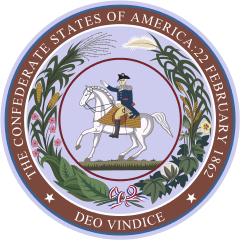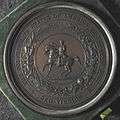Great Seal of the Confederate States of America
| Seal of the Confederate States | |
|---|---|
 | |
| Details | |
| Armiger | Confederate States of America |
| Adopted | 1863 |
| Motto | Latin: Deo vindice |
| Use | on the national currency in 1864 |
The Great Seal of the Confederate States of America, formally the Seal of the Confederate States,[1] was used to authenticate certain documents issued by the C.S. government. The phrase is used both for the physical seal itself (which was kept by the C.S. Secretary of State), and more generally for the design impressed upon it. On May 20, 1863, Secretary of State Judah Benjamin instructed James Mason to arrange for its manufacture in London.[2] The Seal was first used publicly in 1864.
Design
The seal prominently features George Washington on horseback, in the same position as the 1858 Virginia Washington Monument, located adjacent to the Confederate Capitol in Richmond, Virginia.[3] Washington is pictured in his uniform of the Revolution securing American independence.
Washington's first equestrian statue was by Henry Kirke Brown, erected in New York City in 1856. It has since been moved to Union Square in the center of the park. There, the tri-corner hat is held in his left hand rather than atop his head, as depicted in the equestrian statue at the Virginia Capitol, in Richmond. The Union Square statue is duplicated at the Washington Monument at West Point, a bronze statue cast by Clarence P. Towne, dedicated in 1916. Washington was a model for the Confederacy due to his importance in founding a new nation. He was a paragon of personal character, a military leader who secured independence, and a new nation's political leader.
Washington is surrounded with a wreath, which is made of some of the main agricultural products of the Confederacy: wheat, corn, tobacco, cotton, rice and sugar cane. The top margin of the seal features the words "The Confederate States of America: 22 February 1862". This date on the seal commemorates the establishment of the Confederate government in Richmond, Virginia with the inauguration of Jefferson Davis after the only Confederate general election, and is also Washington's birthday.[4]
The bottom margin contains the national motto, Deo Vindice (variously translated as "Under God, [Our] Vindicator", "With God as [Our] Champion", "With God as [Our] Judge", and "Under the Guidance and Protection of God"). The Confederate Senator Thomas Semmes, in proposing this motto, took pains to stress that the Confederacy had "deviated in the most emphatic manner from the spirit that presided over the construction of the Constitution of the United States, which is silent on the subject of the Deity".[5][6] The religious motto reflected the view of, probably, most Confederate citizens: that slavery was condoned by Christianity and thus, by extension, the Confederacy was supported by God.[7]
History
In September 1862, a preliminary seal was proposed for the Confederacy that depicted a Confederate soldier with a bayonet in the foreground, with a woman, child, church, and mountains in the background underneath a shining sun, surrounded by a wreath consisting of four of the major crops of the region: sugar cane, rice, cotton, and tobacco. However, this design was never used.[8]
The design of the seal was finalized on April 30, 1863, and a set of embossing dies ordered from the London engraver Joseph S. Wyon.[9] The seal dies eventually reached Richmond before the end of the war. However, due to the risks of running the Union naval blockade imposed upon the Confederacy, the accompanying embossing press was only shipped as far as Bermuda. The dies (crafted in silver) were thus unlikely to ever have been used in any official capacity.
Both sets of artifacts initially passed through private ownership before ultimately entering museum collections. The dies now reside in Richmond's Museum of the Confederacy; and the embossing press, equipped with brass replica dies, is in a National Trust Museum in St. George's, Bermuda.
Gallery
- Images of the Seal of the Confederate States
-

Early engraving of the Great Seal
-

Early colorized version
-

Electrotype
-

Seal on the 1864 CS$500 banknote
See also
References
- ↑ Matthews, James M., ed. (1863). The Statutes at Large of the Confederate States of America, Passed at the Third Session of the First Congress; 1863. Richmond: R. M. Smith, Printer to Congress. p. 167. OL 25389078M.
- ↑ Beers, Henry Putney (1986). The Confederacy: A Guide to the Archives of the Government of the Confederate States of America. Washington, DC: NARA. pp. 7–8, 74. ISBN 0-911333-18-5. LCCN 86008362. OCLC 13425465. OL 2715333M.
- ↑ "National Register of Historic Places nomination" (PDF). Virginia Department of Historic Resources. Retrieved 5 June 2012.
- ↑ "Great Seal of the Confederacy". Smithsonian National Museum of American History. Retrieved 22 June 2013.
- ↑ "The Great Seal of the Confederacy". Retrieved 22 June 2013.
- ↑ Southern Historical Society Papers. Vol. XVI. Richmond, Va. January–December 1888. pp. 416–422.
- ↑ Rhea, Gordon (January 25, 2011). "Why Non-Slaveholding Southerners Fought". Civil War Trust. Civil War Trust. Archived from the original on March 21, 2011. Retrieved March 21, 2011.
It was a corollary that to attack slavery was to attack the Bible and the word of God. If the Bible expressly ordained slave holding, to oppose the practice was a sin and an insult to God's word... [S]lavery was the will of God, and those who opposed the institution – the abolitionists – were by definition anti-God.
- ↑ Preble, George Henry (1880). History of the Flags of the United States of America: Second Revised Edition. Boston: A. Williams and Company. pp. 523–525. OCLC 645323981. Retrieved March 26, 2015.
- ↑ "Object Record: Great Seal of the Confederacy". National Museum of American History. Retrieved 6 November 2011.
External links
| Wikiquote has quotations related to: Great Seal of the Confederate States of America |
- Seal of the Confederate States at the British Library
- Seal of the Confederate States at the Library of Congress
- Seal of the Confederate States at the University of Georgia